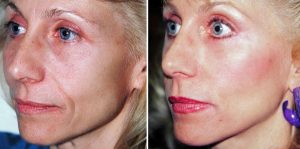
While the midface does get some mild rejuvenative effects from browlift and lower facelift procedures, more profound effects require a direct approach. In considering a midface lift the single most important questions are the vector that the tissues needs to be suspended and how to do it. Such considerations have led to a wide variety if espoused midface lift techniques none of which have been shown to provide unequivocal outcomes.
In the May 2015 issue of the journal Plastic and Reconstructive Surgery, an article entitled ‘Midface Rejuvenation: A Critical Evaluation of a 7-Year Experience’ was published. In this paper the authors review their midface lifting experience in 350 patients over a 7 year period. It should be noted that the majority of the patients (73%) had a midface lift combined with a facelift while the minority (27%) had it as an isolated procedure. Two basic midface lift procedures were used, a superolateral vector with temporal suture suspension or a superomedial vector with bone fixation to the inferior orbital rim. The results of both techniques was assessed improvements in the malar eminence, nasojugal groove, nasolabial fold and jowl areas after 24 months. The midface lift with temporal anchoring more effectively treated the malar eminence while the midface lift with orbital rim fixation more effectively treated the nasojugal groove.
While the midface lift has been labeled as a ‘problematic’ procedure that is prone to a significant risk of lower eyelid problems, this large patient series showed high satisfaction rates. They did demonstrate that there is significant swelling around the eyes that took 2 to 3 weeks to get a lot better and really a full two months for a complete recovery. This is a critical issue to point out to patients before surgery as weeks of an abnormal and distorted appearance can be very distressing to most patients. In short a midface lift has a longer recovery than a lower facelift due to its periorbital location.
This paper also demonstrates that the vector of a midface lift needs to be individualized for each patient based on the most pronounced sagging area. It is no surprise that a superolateral vector of suspension works better for lateral orbital areas while a more superior vector improves the medial orbital sag. The authors did not address that a combination of superolateral and superior suspension can be used in the same patient if so indicated.
Dr. Barry Eppley
Indianapolis, Indiana


